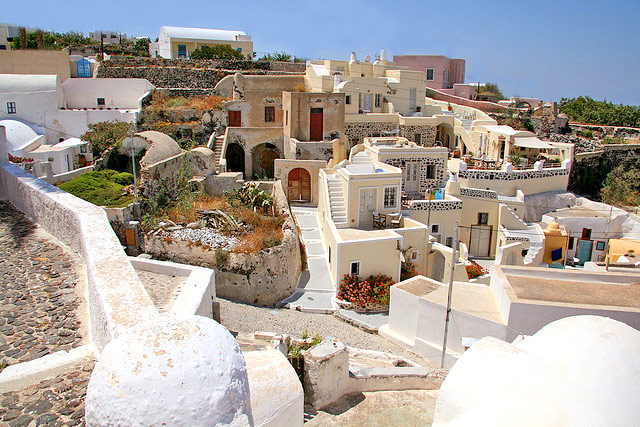The gateway to Oia village when entering from the south (the road from Fira or Imerovigli) is Perivolas. It is a neighborhood composed of cave houses and captains mansions with courtyards. The desalination plant of Oia is located in Perivolas, next to Saint Vasileios church. This specific location offers a great view to the village of Oia which looks like a long and narrow settlement.
The cemetery of the village is situated on the left slope of Perivolas and a monument known as Heroon (devoted to the heroes – the villagers who died during the World War II) has been erected in the paved square, surrounded by pine trees. There is a small church to the north of the square which used to be the old cemetery chapel as, in the past, the cemetery was located at the point of Heroon monument. The chapel is devoted to Jesus Christ and it is known as Christ of the Heroes.
Having a look at the present cemetery of the village, one can read the maritime life of the old residents who have been buried there. The names of captains and seamen families have been engraved on the old graves which are accompanied by marble anchors, ship reliefs, ornate crosses and other items related to nautical past of those people.
The most imposing building of Perivolas is the church to Saint Georgios. It has a large yard with cypress trees and it used to be the centre of old Oia (known as Pano Meria in the past) by the time the earthquake occurred in 1956, when it was destroyed. The churh of Saint Georgios was rebuilt in 1965. Nowadays, one can also see a small chapel built at the edge of Saint Georgios church courtyard, devoted to Virgin’s Dormition.
A great feast was taking place annually on the name day of Saint Georgios and all the inhabitants of the village took part in it. The most important custom of this feast which, in fact, was a panigyri (village party) was the transferring of Saint Georgios’s banner from the Piraeus to Oia. During the rest of the year, this banner was kept in Saint Spyridon’s church in Piraeus, by Oians who lived there. People used to wait for the ship transferring the banner at Armeni port where they welcomed it and continuously they participated in the pomp to the church where a ceremony took place.
Finikia
Finikia is a settlement located to the southeast of Oia village, no more than 15 minutes walking away from Oia. Actually, it is an inland village on the northwest side of Santorini island which looks down Baxedes beach and towards the sea and Ios island. Vineyards or other cultivations are grown on the slopes of Finikia which is crossed by a street known as “potamos” (river) because the rainwater rushes along it.
Houses, churches and cave houses have been built on both sides of the street. As they were not affected seriously by the earthquake (1956) their past original architecture has been preserved. Contrary to Oia, the houses of Finikia do not have to balance on the rocks of the steep cliff. Given that they have been built on a flat ground, they stand gracefully within a different aesthetics, more spacious, more harmonically and much more functional than those of Oia. They have large and impressive facades, courtyards and stairways, outdoors ovens and chimneys that have been constructed according to the rules of the measure.
Nowadays, some of the large cave houses of Finikia are uninhabited and stand silent, covered by flowered beds bushes. They remind people of the glorious past of the village and let visitor feel as if travelling in the past while strolling between them where one can see the small churches every now and then appearing between the cave houses, black stone walls and arched courtyard doorways, carnations in tin cans, low bushes by the road and smell the thyme and oregon grown at the slopes of the village slopes.

Finikia Oia
A small stairway to the right, along the river street of Finikia, ends to the courtyard of Saint Matrona’s church. It is a pink painted church and a palm tree adorns its courtyard. The name day of the church is on October 20th and a joyfull feast (panigyri) takes place then.
The residents of Finikia were mainly farmers who cultivated the earth around the village. The exported their products to other countries thank to the sailing ships that departed from the port of Oia.
